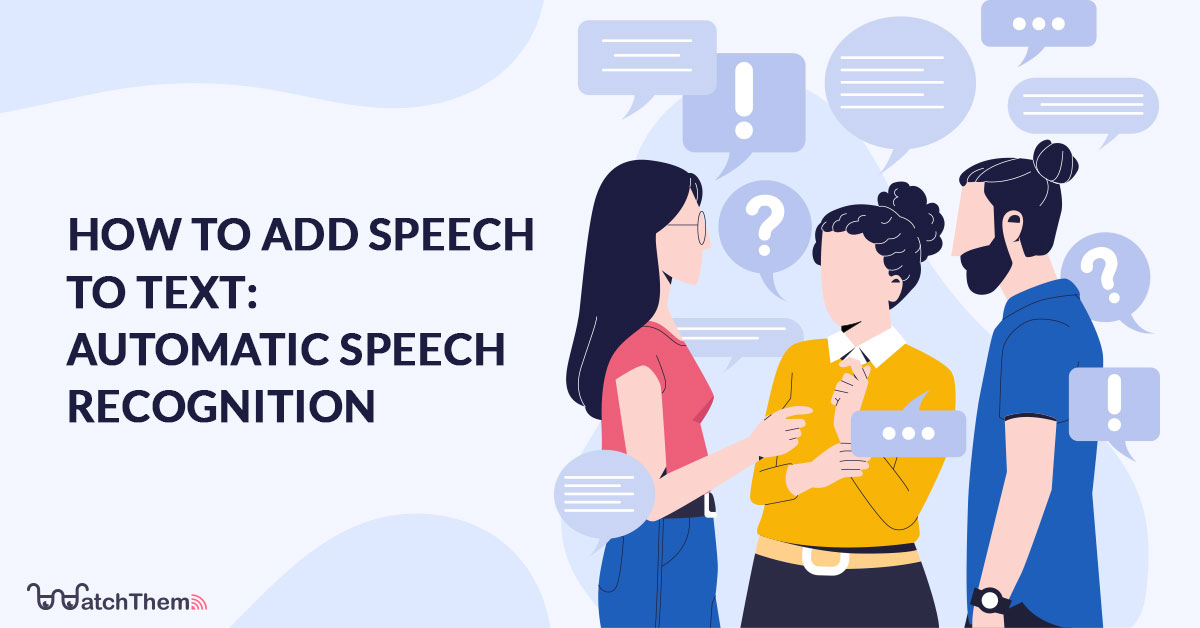Page Contents
Time never stops. It is a precious resource that is scarce and has no substitute. This is why we often find ourselves trying to save time while performing our daily activities. One such recently-brought technology with which you can save time is speech-to-text technology.
As per a research, 79% of the respondents selected ‘time-saving’ as a benefit of consuming speech-to-text services. It eliminates the time required in manually typing speech. It can recognize human speech and convert it into text automatically.
So, do you want to learn how to add speech to text? If so, you’ve come to the right place.
This article will teach you everything you need to know about automatic speech recognition (ASR). We’ll discuss what ASR is, how it works, and the benefits of using it. Plus, we’ll provide a step-by-step guide on adding speech to text in your projects.
Let’s get started:
What Is Automatic Speech Recognition?
Automatic speech recognition (ASR) is a technology that enables computers to interpret and convert spoken words into text. This process is often called “speech-to-text” or “voice recognition.” ASR can be used in various applications, including voice control, translation, and text transcription.
How Does Automatic Speech Recognition Work?
Automatic speech recognition is a complex process that involves several steps. Here’s a general overview of how it works:
- First, the audio signal is converted into text using a speech recognition engine.
- This text is then analyzed to determine the words and phrases in the speech.
- Finally, the text is converted into a human-readable format.
What Are the Benefits of Automatic Speech Recognition?
There are many benefits to using automatic speech recognition. Here are some of the most notable:
- Increased Productivity: Speech recognition software can help you become more productive by allowing you to control your computer with your voice.
- Convenience: With speech recognition software, you can do things like make phone calls, send text messages, and check your email without ever having to touch a keyboard.
- Accuracy: Speech recognition software is very accurate, and can often understand natural speech patterns, sometimes even better than humans.
- Multilingual Support: Many speech recognition engines support multiple languages, making it easy to convert speech into text in multiple languages.
Text to Speech vs. Speech to Text
Speech to text is often confused with text to speech; however, there is a difference between them, and these technologies perform functions different from each other. Let’s see how:
Text to Speech
Text to speech takes a written text and converts it into an audio file. This is done by providing a textual script to a text to speech software which then provides options to choose from a lot of AI voices. Finally, that textual script is converted into an audio script with the help of AI voices.
Text to speech can be used for several purposes, such as creating audio files for presentations or podcasts or simply listening to a story.
One drawback of text to speech is that the audio file’s quality can depend on the speaker’s voice and pronunciation. Since the AI voices are used generally, the chances are that they might not sound very natural. In addition, because text to speech may sound unnatural, it may not be suitable for long audio files.
Speech to Text
Speech to text takes spoken words and converts them into written text. This is done by recording the spoken words and then converting them into text.
Speech to text is perfect for transcribing interviews, speeches, or meetings. One benefit of speech to text is that it saves a lot of time that would have been spent manually transcribing the speeches. It is also usually accurate, meaning that there are very few errors in the transcription.
How to Add Speech to Text in Your Projects
Now that you know what automatic speech recognition is and its benefits, let’s walk through a step-by-step guide on adding speech to text in your projects.
Step 1: Install a Speech Recognition Engine
The first step is to install a speech recognition engine. There are many different speech recognition engines available, both free and paid. Here are some popular options:
- Google Speech API: This is a free speech recognition engine available on the Google Cloud Platform. It supports multiple languages and has a high accuracy rate.
- IBM Watson Speech to Text: This is a paid speech recognition engine that supports over 30 languages. It has a very high accuracy rate and includes features like text formatting, punctuation correction, and automatic paragraph splitting.
- Nuance Dragon: This is a paid speech recognition engine that supports over 20 languages. It has a high accuracy rate and includes features like text-to-speech conversion, transcription editing, and personalized word lists.
Once you have chosen a speech recognition engine, follow the instructions on how to install it in your project.
Step 2: Configure Your Speech Recognition Engine
For your application to use the speech recognition engine, you will need to configure it correctly. This involves specifying the language of the text, the audio input source, and other settings. The exact configuration process will vary depending on the engine you are using, so be sure to follow the instructions provided by the manufacturer.
Step 3: Collect Audio Samples
Before you can start recognizing speech, you will need to collect some audio samples. This involves recording a few minutes of spoken text in each language you want to support. Be sure to speak naturally and avoid speaking too quickly or slowly. Once you have collected your audio samples, save them in a safe place for later use.
Step 4: Train Your Speech Recognition Engine
Now it’s time to train your speech recognition engine. This process involves feeding your audio samples to the engine so that it can learn how to recognize the text in each language. The exact training process will again vary depending on the engine you are using, so be sure to abide by the instructions provided by the vendor.
Step 5: Use Speech Recognition in Your Application
Finally, it’s time to start using speech recognition in your application. This involves calling the speech recognition engine’s API and passing in the text you want to convert into speech. Be sure to test your application thoroughly to ensure that everything is working correctly.
That’s it. Now you know how to add speech recognition to your projects.
Some Tips for Using Speech Recognition Software Successfully in Your Business or Project
There are many ways to use speech recognition software successfully in your business or project. Here are some tips to get started:
1. Use It to Dictate Text:
This is probably the most common use of ASR. You can simply speak into your device or computer, and it will convert your words into text. This is great for taking notes or writing papers. It will help you understand how it works and how you can improve its performance.
Note: if you need to dictate text, practice beforehand to get used to the rhythm of speaking. This will help ensure that your text is accurate.
2. Use It to Control Devices
ASR can also be used to control devices. This can be done with voice commands or by speaking into a microphone. This is a great way to hands-free control your device.
Note: if you need to control devices, practice the commands beforehand. This will help ensure that you get the desired results.
3. Use It to Enter Information
ASR can also be used to enter information into programs. You can speak into your device or computer, and it will automatically enter the text into the program. This is a great way to save time when typing.
Note: if you need to enter information into a program, make sure the program is open and ready to accept input. This will save time and ensure accuracy.
4. Use It for Specific Tasks
For example, if you want to add speech to text for a website, you need to use software that can do this effectively.
5. Use It in Combination with Other Tools
For example, if you need to add speech to text for a video, you should also use speech recognition software with video editing software.
6. Use Quality Grammar Checkers
Use quality grammar checkers to ensure that your automated speech recognition (ASR) software uses correct grammar. This will ensure that your customers get the information they need and that their conversations with you are accurate.
When you use quality grammar checkers, you can be sure that your ASR software is working as it should. Additionally, by checking for proper grammar, you can help reduce the number of customer interactions required because they will clearly understand what your ASR program is meant to answer.
7. Choose the Right Automatic Speech Recognition Engine
There are a number of automatic speech recognition engines available on the market. Make sure that you select the program best suited for your business.
For example, if you’re a small business, you may want to look for a program that is easy to use, cost-effective, and has a limited amount of features.
On the other hand, if you’re a large company with a lot of customer service needs, you may want to consider a more complex program.
Conclusion
In this article, we have taught you everything you need to know about automatic speech recognition. We have answered the most common questions, such as what ASR is and how it works. We have also shown you how to set up ASR on your device and given some tips on using it. Automatic speech recognition is a great tool, and we hope you find this guide helpful.


Author’s Bio:
Saifullah Napar is a content writer working in this field for the past three years. He has been writing on topics such as business technology, blockchain, fintech, and digital marketing. (LinkedIn)




